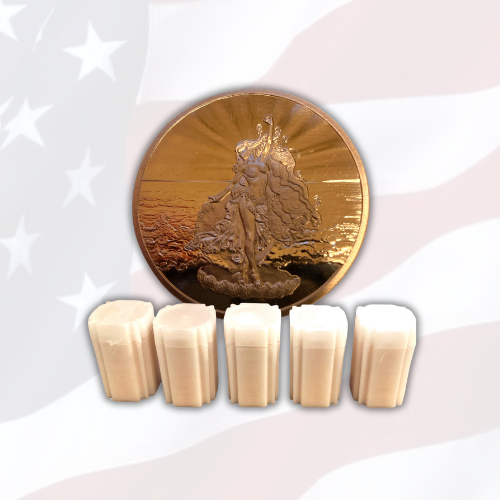How Copper Stacks Up: A Deep Dive into Metal Densities and Their Value
When it comes to investing in metals, understanding the density, value, and applications of each metal is crucial. Did you know that copper is not just a electrical conductor but also a significant player in the realm of metal investments? In this blog post, we will dive deep into the world of copper and compare its density with other popular metals, such as silver, titanium, gold, aluminum, steel, and palladium. We’ll discuss not only how they stack up in terms of density, but also their value, applications, and benefits, helping potential investors make informed decisions. By the end of this post, you'll have a better understanding of why copper can be an excellent investment opportunity alongside other metal.
Understanding Metal Density
Density is defined as mass per unit volume, which means how much a given amount of the substance weighs in a specific space. Different metals have varying densities that contribute to their unique properties and applications.
Copper: The Basics
Copper has a density of approximately 8.96 g/cm³. It's widely known for its excellent electrical conductivity, malleability, and resistance to corrosion. These attributes make copper a vital material in various industries, particularly in electrical wiring and plumbing.
Density Comparison with Other Metals
To better understand how copper stands against other common metals, let’s look at their densities, applications, and current market values.
1. Silver
- Density: Silver boasts a density of 10.49 g/cm³, making it denser than copper.
- Applications: Silver is utilized in electronics, jewelry, and medical instruments due to its conductivity and antibacterial properties.
- Value: Silver's market price fluctuates around $25 per ounce, though it can vary based on demand and geopolitical factors.
When comparing copper and silver, while silver is denser and more expensive, copper is still more cost-effective for bulk applications.
2. Titanium
- Density: Titanium has a lower density at about 4.51 g/cm³, making it lighter than both copper and silver.
- Applications: Known for its strength-to-weight ratio, titanium is widely used in aerospace, medical devices, and high-performance alloys.
- Value: Titanium's price ranges around $4.50 per pound, making it relatively affordable compared to silver and gold.
While titanium may not be as dense as copper, its unique properties make it perfect for specific applications, particularly where weight is a concern.
3. Gold
- Density: Gold is considerably denser, hovering around 19.32 g/cm³.
- Applications: Gold is used in electronics, jewelry, and as a financial asset due to its status as a safe-haven investment.
- Value: Currently, gold trades for approximately $1,800 per ounce, significantly higher than both copper and silver.
In terms of investment, while gold offers stability, copper provides opportunities in electrical applications and the growing green technology sector.
4. Aluminum
- Density: Aluminum has a density of about 2.70 g/cm³, making it one of the lightest metals available.
- Applications: Its lightweight nature makes aluminum fantastic for transportation, packaging, and construction.
- Value: Aluminum prices fluctuate around $1 per pound, making it an economical choice compared to copper.
Although aluminum is lighter, copper’s density and conductivity are unmatched for electrical work, giving it a niche that aluminum cannot fill.
5. Steel
- Density: The density of typical steel ranges from 7.75 to 8.05 g/cm³, putting it close to copper.
- Applications: Steel is widely used in construction, automotive, and manufacturing due to its strength.
- Value: Steel is often priced per ton; current rates can be between $700 to $900.
Steel's density similar to copper’s allows it a foothold in construction, but for electrical conductivity, nothing beats copper.
6. Palladium
- Density: Palladium has a density around 12.02 g/cm³, making it denser than copper but less than gold.
- Applications: Used mainly in catalytic converters and electronics, its demand has soared in recent years due to environmental regulations.
- Value: Palladium's value is currently over $2,000 per ounce, making it one of the most expensive metals.
Investors pondering copper vs. palladium should note that while palladium's price is high, copper remains essential and more affordable for practical applications.
Benefits of Copper
- Conductivity: Copper is a superb conductor of electricity and heat, making it ideal for wiring systems and electrical devices.
- Corrosion Resistance: Copper does not rust, contributing to its long lifespan in plumbing and roofing materials.
- Versatility: It can be shaped easily for various applications, ranging from simple wires to complex circuits.
- Antimicrobial Properties: Research shows that surfaces made of copper can reduce the spread of germs, making it a practical choice for medical equipment.
- Cost-Effectiveness: Compared to precious metals like gold and silver, copper is more affordable while providing excellent functionality and investment return potential.
Why Density Matters
Choosing the right metal for a specific application depends heavily on density. Lighter metals like aluminum may serve in specific cases, but for any situation requiring conductivity and strength, copper holds the upper hand.
Conclusion: Your Path to Informed Metal Investing
Understanding metal densities not only aids in practical applications but also enhances investment strategies. Copper stands out for its versatility and relative affordability. Armed with knowledge about densities, prices, and applications of various metals, potential investors can make educated decisions.
So now what? Consider diversifying your investment portfolio with metals that matter—copper has proven to be a reliable performer in various markets. Explore this critical metal further, assessing how it compares against other investment metals. Interested in learning more about copper and how it could fit into your long-term investment plans? Visit us at [Your Link Here] to dive deeper into beneficial investing opportunities.


